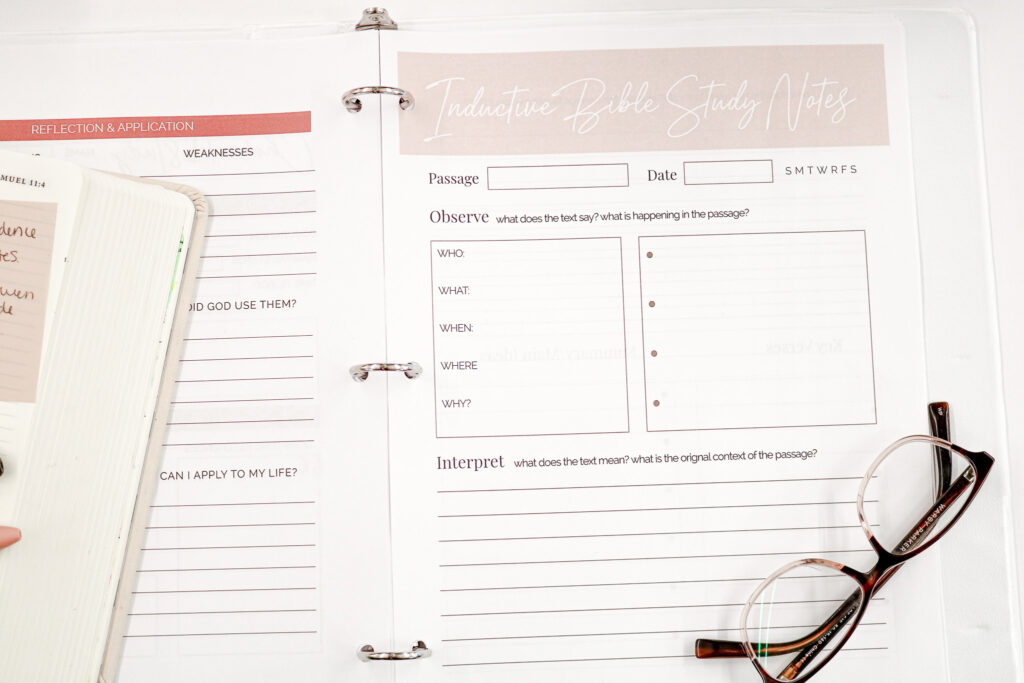How to Do Inductive Bible Study: A Step-by-Step Guide

What is inductive bible study?
Inductive Bible study is a method of digging deep into Scripture and learning to interpret what it means and apply it to your own life.
This method is comprised of three basic steps: Observe, Interpret, and Apply.
We will use inductive reasoning to observe what the Bible is saying, interpret what it is trying to say and apply it to our personal lives and situations.
Inductive Bible study is deep and slow but is incredibly fruitful. This method is more than just reading your Bible. Learning how to study the Bible inductively will gain the student a robust understanding of the Scriptures, and therefore, of their faith and God.
Inductive vs. Deductive Reasoning
Inductive reasoning is used in this Bible study method to draw conclusions from Scripture. This type of reasoning is defined as making general conclusions from specific information.
Deductive reasoning is the opposite, drawing specific conclusions from general information. Deductive reasoning begins with a specific statement that is assumed to be true. That statement is then used to draw general conclusions. This kind of reasoning is dangerous in Biblical study because it brings to the table our assumptions that color how we interpret the Bible.
When we study the Bible inductively, we bring no assumptions to the able. We take what is in front of us (the Scripture) and only that information to draw conclusions or applications.
The other way around is someone working to fit the Bible into a preconceived notion or idea.
What are the 5 W’s of inductive Bible study?
The 5 Ws of the Inductive Bible study are the main questions we ask of the text when gathering background to interpret the Scripture correctly.
The 5 Ws are:
- Who?
- What?
- When?
- Where?
- Why?
Answering these questions will orient you to the original time and place of the passage you are studying. This is vital to proper personal Bible study because the Bible is not only the living Word of God but a historical text, written to another set of people in another place and another time.
In the next section, we will dive into each step and how to gather the background and context of your passage.

How to do inductive Bible study?
Inductive Bible study does require a few more tools than just a Bible and a pen. Things you will need to dig dip with this method are:
- A Bible (I prefer a journaling Bible for this kind of study)
- A Study Bible in another translation
- Optional: A printed, double-spaced version of your passage
- Optional: An inductive Bible study template
- Pens
- Bible Highlighters
- Bible Dictionary or Concordance
- Trusted commentary source (Blueletterbible.org or Studylight.org are great options)
Some people like to utilize Bibles made specifically for methods that utilize a lot of marking, like inductive study or Bible journaling. Bibles like the Spiral Bound Inductive Bible Journals would be a great choice if you are someone who wants to study this way but does not want to write in the pages of your personal Bible.
Printing a double-spaced version of your passage is another cost-effective option. Find your passage online and copy it into Word or a Google Doc and double-space it. Then, clean up your document and print it! You can remove any annotations or leave them in.

Step One: Background
Inductive Bible study has three main parts, but gathering background is a necessary first step for this. method.
To make observations and interpret and apply Scripture, we need to seek to understand it as best we can. Gathering the background information will allow us to do that.
This step is what I like to call “reading the envelope.” If you receive a letter in the mail, the first thing you do is try to gather as much information as you can from the outside. Is it addressed to me, or someone else who lives here? Or someone who doesn’t? Who is it from?
Answers to these questions determine what you do with the piece of mail. The same is true with our BIble study. To orient yourself to your passage, answer the following questions:
- Who wrote it?
- To whom was it written?
- When was it written?
- What type of book is it? (Ex. Historical narrative? Poetry? Gospel? Epistle? Law?)
- What are the central themes?
Most study Bibles will contain this information at the beginning of each chapter. If you are doing a book study, you only need to look up this information once and then continue to refer back to it each day that you study.
Step Two: Observation
The majority of your inductive Bible study should be spent on this step. Many make the mistake of skipping into the meaning or application of a passage too soon.
Spending a lot of time on the observation step will keep you from misinterpreting Scripture or applying it incorrectly.
Ask Questions
As you make observations of the passage you are reading, answer these questions:
- Who is in the passage? Who is speaking or narrating? How are they described?
- Where are they? What is their location? Are they traveling?
- What are they doing?
- When? Make a note of the timeframe.
- Why? Is there a reason these events are happening? A reason why the person is speaking on that topic?
These questions are similar to our background questions but will be much more specific to the passage, rather than the book as a whole. You can write these out or use markings to indicate the answers, such as circles for characters and rectangles for locations, etc.
notations
As you read your passage, you will want to make a note or annotate things like:
- sentence structure
- verb tense (past, present, future, etc.)
- Repetition of words or phrases
- God speaking
- References to Jesus or the Gospel
- Cross-references (see more about those below)
- Transition words (ex. therefore, then, because, if, etc.)
- Lists
- Comparisons
- Promises or Commands
- Words you don’t know
- Questions that come up
Definitions
Note any words you do not fully understand or simply want to define. Look up the definitions and write them out.
Write out the synonyms and antonyms. Go as deep as you want.
Next, look up your words in the original language. This is called doing a word study and can help you to understand the overall passage better.
cross-references
Cross-references are places in the Bible where the same verse, idea, theme, or person is referenced. The Bible is one big story and often references itself.
Looking up those cross-references and reading them can help you with interpretation and connections within Scripture.
Step Three: Interpretation
This step is when we finally get to draw our conclusions on what our passage means or is saying to us.
While this can be the most difficult step, the work we have done in the previous steps should make meaning much easier to conclude than if we have simply read the passage and tried to apply it to our lives.
Rules for Sound Interpretation
The task of interpreting Scripture is to uncover the original author’s intended meaning. This book was written many years ago in multiple original languages that most of us do not know. To interpret properly, we must seek understanding, no matter if we agree with it or not. God’s Word is the final word.
We must be diligent students of Scripture with no agenda but to know God and His Word better. Here are some things to keep in mind to be sure you are interpreting Scripture well.
#1 Scripture Interprets Scripture
In places where you may find Scripture to be gray or vague or even silent, we defer to where Scripture is clear. Our interpretation of a vague or confusing Scripture never supersedes or trumps Scripture where there is clarity.
Utilize cross-references when you are studying to see where else your topic or verse is discussed in Scripture. Be careful not to make sweeping theological conclusions based on isolated verses or verses where there are no other references made in the Bible.
#2 We interpret Scripture within the scope of the WHOLE Bible.
One Scripture does not negate nor nullify overarching themes of the entire Bible.
Many of the letters and passages in the Bible were written to a specific church or place that had specific problems. We should interpret those instances in light of all of Scripture and not in isolation.
For example, in 1 Corinthians, Paul shares that he views marriage as a distraction from furthering the Gospel (1 Corinthians 7) and states that the unmarried should stay that way. It would be a poor interpretation to say that, based on this passage, marriage is wrong and we should all stay single.
Instead, we would look to the overall theme of marriage in Scripture and see that it is a blessing and a picture of our eventual marriage to the Bridegroom in Heaven.
Interpretation Exercises
There are many ways to interpret your passage, but here are three helpful exercises to assist with this process.
Summary
Once you have read and made your observations, summarize what you have read as concisely as you can. In this exercise, don’t focus on the details. Look for the overall message and theme of your passage.
To summarize, you must take the main ideas of the passage and take it down to just a couple of sentences. This exercise will help you to interpret the overall message of what you are studying without getting hung up on any details.
What is God saying to you in the passage?
Paraphrase
Paraphrasing means to rewrite something in your own words. This requires you to know what each verse means and rewrite it. This is a great exercise for interpretation, though it is more laborious than summarizing.
Take each verse of your passage and rewrite it in your own words. The rule for paraphrasing is that your sentences have to be different. The same words can be used, but be sure to utilize synonyms and parallel wording or phrases.
This exercise may be difficult if you are new to Inductive Bible study, but you will get better with time and practice! Do not worry about being wrong; just be careful with how tightly you hold to your conclusions.
Give your interpretations back to God in prayer, asking Him to correct, convict, and confirm what you have taken from His Word.
Questions for Interpreting
If you need a simpler exercise or additional help with interpretation, try journaling through some of these questions.
- Why did the author choose this word?
- Why did the author not say _________?
- Why did God use this person?
- Why did this happen at this time?
- What is the meaning of this word?
- What is the significance of this phrase?
- What is the main point of this passage?
- What did the character(s) learn in this passage?

Step Four: Application
The final step in the Inductive Bible Study method is to apply what you have learned to your life and your heart.
This is the step where you can make it about you. What does God want you to do with what you read?
Here are some questions to ask when applying Scripture:
- What is God saying to me through this passage?
- What has this passage taught me about God’s character?
- How does this passage call me to live?
- Is there any command or direction here I need to obey?
- Are there any promises here for me to cling to?
- How does this passage change my actions or character?
- How does this passage change my relationships with others? (marriage, friendships, family, etc.)
- Is there an action or attitude in this passage I need to emulate in my own life?
- Is there something here I need to pray for? For myself or someone else?
End With Prayer
Close out your inductive Bible study time with prayer. Thank God for His Word and ask Him to continue to reveal truth to you throughout your day.
Ask Him to correct and convict you through your time of study.
I pray this guide will bless your Inductive Bible study time and make it fruitful.
Your Sister in Christ,







